The Striated Heron (Butorides striata), also known as the mangrove heron or little heron, is a small, secretive bird species belonging to the heron family, Ardeidae.
Characterized by its striking plumage and slender build, the Striated Heron is predominantly found in coastal and freshwater habitats across the globe, spanning regions from Africa and Asia to the Americas.
Its distinctive appearance includes a finely streaked neck and breast, contrasting with a solid-colored back and wings.
With a keen eye for prey, this adept hunter feeds on a diverse diet consisting of fish, crustaceans, amphibians, and insects.
Despite its diminutive size, the Striated Heron is a skilled predator, often observed stealthily stalking its prey along the water’s edge or perched on overhanging branches.
Its adaptability to various environments and remarkable hunting prowess make it a fascinating subject for bird enthusiasts and researchers alike.
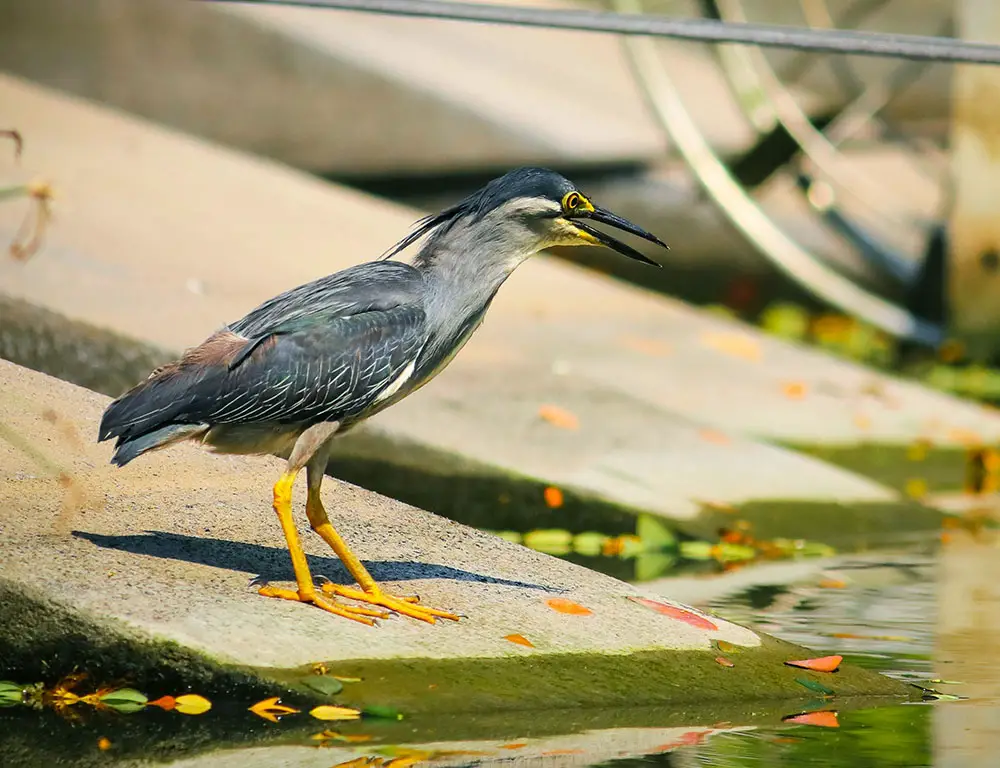
Charming Characteristics Of Striated Heron
The Striated Heron (Butorides striata), also known as the Little Heron, is a small and stealthy wading bird found in various wetland habitats worldwide.
Despite its diminutive size, this heron possesses several distinct physical characteristics that aid in its survival and hunting prowess.
Plumage
The Striated Heron boasts a distinctive plumage, featuring a black forehead and crown, complemented by a greenish-black back.
Its underparts are gray, adorned with a prominent central white stripe. Notably, its legs are a striking bright yellow-orange hue.
This small heron species is commonly sighted foraging solitarily amidst dense vegetation bordering water bodies, showcasing its adaptability and stealthy hunting techniques.
Long Neck And Bill
This heron’s long, slender neck allows it to strike at prey swiftly in the water. Its thin and pointed bill is perfectly adapted for catching small fish, amphibians, and insects.
Short Legs
The Striated Heron has relatively short legs, unlike some larger heron relatives. This adaptation enables it to easily navigate through dense vegetation and shallow water, making it an adept hunter in marshy habitats.
Yellow Eyes
One of the striking features of the Striated Heron is its bright yellow eyes, which stand out against its gray-blue plumage. These keen eyesight aids in spotting potential prey and predators in its surroundings.
Crest
During breeding season or when displaying aggression, the Striated Heron may raise a short crest of feathers on its head. This behavioral characteristic adds to its overall appearance and may serve as a visual signal to other individuals.
Compact Body
The Striated Heron’s compact and streamlined body allows it to move quickly and stealthily through its wetland habitats. Its small size also makes it less conspicuous to potential threats.
Wing Shape
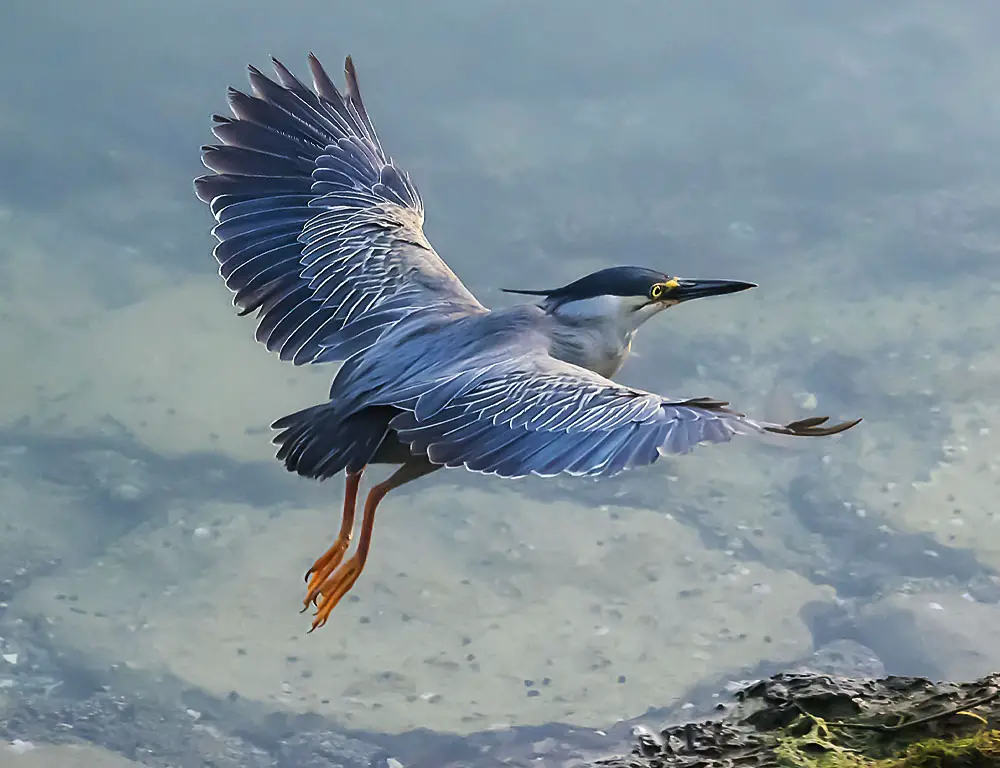
Its broad and rounded wings provide efficient propulsion during flight and allow for precise maneuvering when hunting or navigating through dense vegetation.
Identification
The Striated Heron can be identified by its distinctive gray-blue plumage, fine streaks or striations, compact body, and bright yellow eyes. Its long neck and bill, short legs, and broad wings further aid in its recognition.
Distribution And Habitat
Striated Herons primarily inhabit small wetlands within the tropics of the Old World, spanning from west Africa to Japan and Australia. They also reside in South America and the Caribbean.
Typically sedentary in nature, these herons demonstrate a preference for remaining within their breeding habitats, which consist of mangroves, marshes, and other similar coastal or freshwater environments.
Their sedentary lifestyle contributes to their intimate familiarity with local territories and behaviors.
Reproduction
Striated Herons typically breed in solitary pairs, constructing nests from twigs and vegetation in trees or bushes near water. They lay 2-5 eggs in clutches, and both parents share incubation and chick-rearing duties.
Lifespan/Longevity
The average lifespan of the Striated Heron (Butorides striatus) is approximately 7.9 years. Despite its relatively short lifespan, this species contributes to the diverse ecosystem dynamics within its habitat.
Communication And Perception
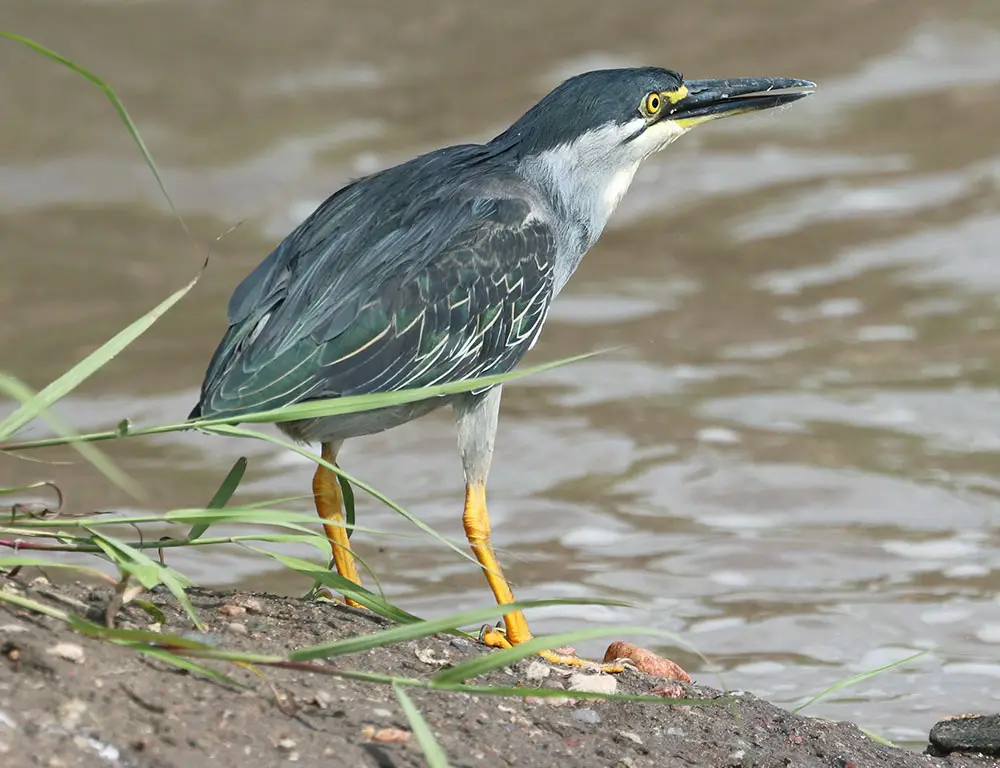
These herons communicate through various vocalizations, including squawks, calls, and alarm signals. They also rely on keen eyesight to detect prey and potential environmental threats.
Taxonomy
Here’s a table outlining the taxonomy of the Striated Heron (Butorides striata):
| Taxonomy Level | Classification |
| Kingdom | Animalia |
| Phylum | Chordata |
| Class | Aves |
| Order | Pelecaniformes |
| Family | Ardeidae |
| Genus | Butorides |
| Species | Butorides striata |
Nesting Habit Of Striated Heron
Here’s a table outlining the nesting habits of the Striated Heron:
| Nesting Habit Feature | Description |
| Nesting Sites | Trees, bushes, reed beds, or dense vegetation near water bodies such as rivers, lakes, ponds, or marshes. |
| Nesting Material | Constructed from sticks, twigs, and vegetation, often lined with softer materials like leaves or grass. |
| Nesting Behavior | Solitary breeders construct nests in secluded locations away from potential predators. |
| Nesting Season | Breeding season varies depending on location, often coinciding with favorable weather conditions. |
| Nesting Location | Elevated sites such as trees or shrubs are preferred for nest building to avoid flooding and predation. |
| Nesting Colonies | Striated Herons typically nest solitarily but may be found in loose colonies during breeding. |
| Nesting Incubation Period | Incubation lasts several weeks, with both parents sharing incubation duties and caring for the chicks. |
| Nesting Chick-Rearing Duties | Both parents feed and care for the chicks until they fledge and become independent. |
Food Habits
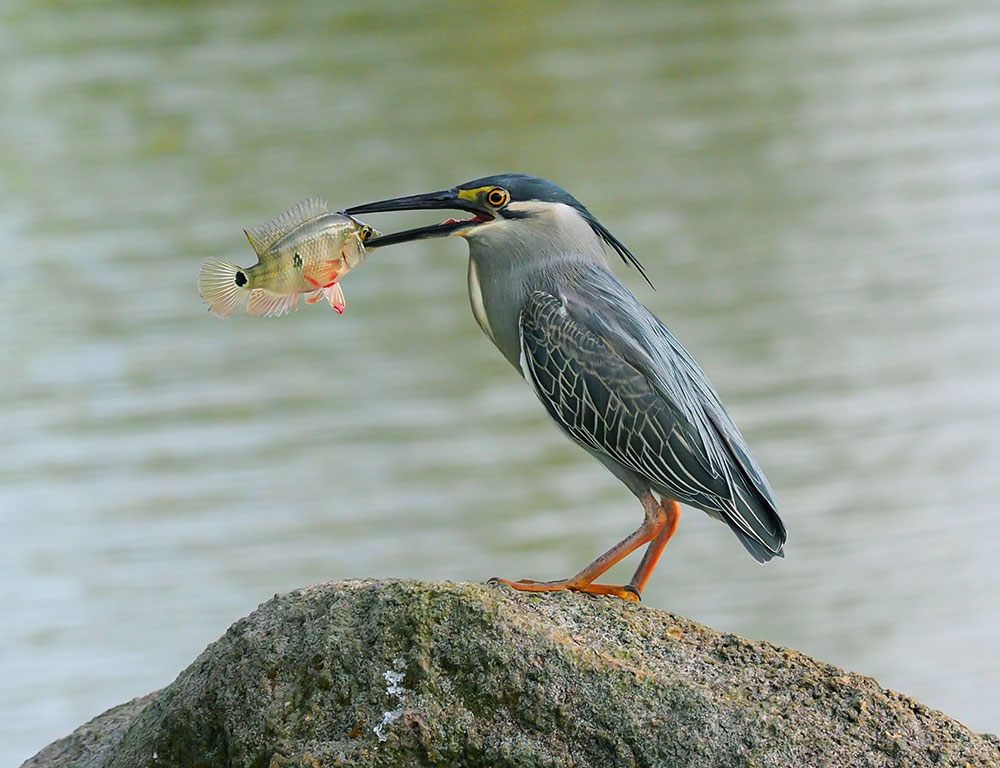
Striated Herons primarily feed on small fish, amphibians, crustaceans, and insects, which they catch by patiently stalking prey along the water’s edge or from a perch above the water.
Conservation Status
The Striated Heron is generally considered the least Concerned on the IUCN Red List, with stable populations across its range. However, localized threats such as habitat loss and pollution may impact specific populations.
Conservation efforts focused on preserving wetland habitats and mitigating human disturbances are crucial for the long-term survival of Striated Heron populations. Protected areas and habitat restoration projects play a vital role in their conservation.
Threats
Common threats to Striated Herons include habitat destruction, pollution of water bodies, disturbance from human activities, and predation by invasive species. Climate change may also impact their habitat availability and food sources.
In Culture
Striated Herons have appeared in various cultural contexts, often symbolizing adaptability, patience, and resilience. They are also featured in indigenous folklore and art, highlighting their significance in human imagination and storytelling.
Behavior And Ecology
Striated Herons are solitary hunters who employ stealth and patience to capture prey. They are often observed standing motionless at the water’s edge or perched on overhanging branches, waiting for the perfect moment to strike.
These common characteristics shed light on the fascinating biology and ecological significance of the Striated Heron, a charismatic inhabitant of wetland ecosystems worldwide.
Ranging Map
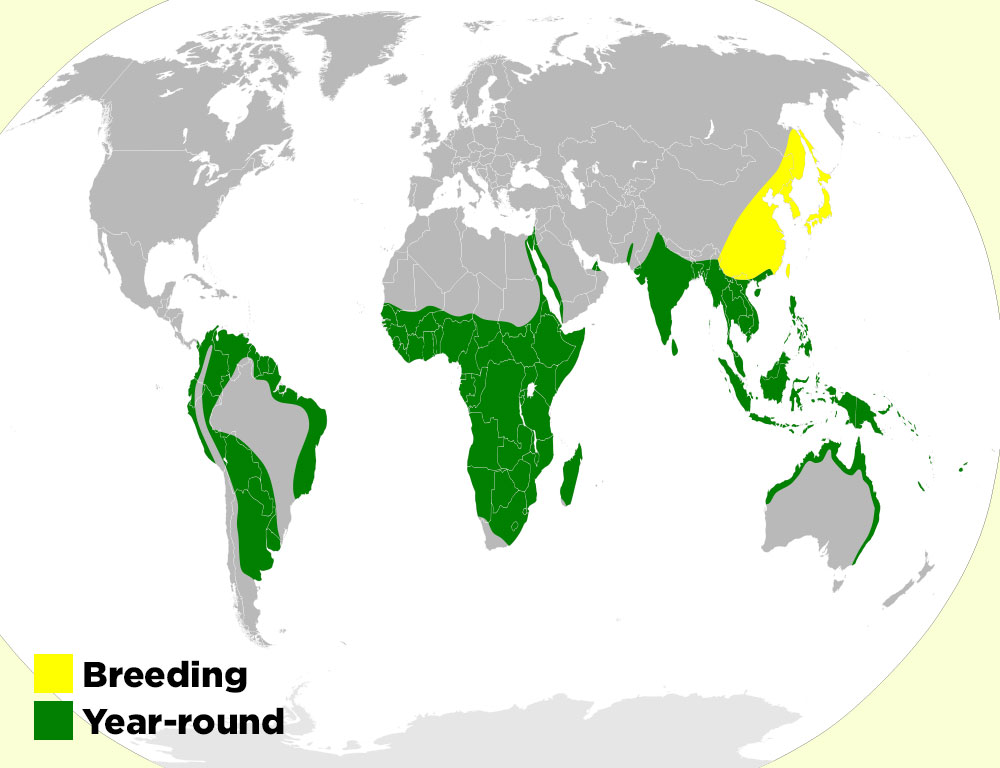
The ranging map of the Striated Heron (Butorides striata) illustrates the widespread distribution of this adaptable wading bird across various wetland habitats worldwide.
These herons can be found in a diverse range of ecosystems, from tropical marshes and mangrove swamps to temperate estuaries and riverbanks.
The map showcases the Striated Heron’s extensive geographic range, spanning regions in Africa, Asia, the Americas, and even parts of Europe. Its presence in fresh and saltwater wetlands highlights its adaptability to aquatic environments.
Difference Between Green And Striated Heron
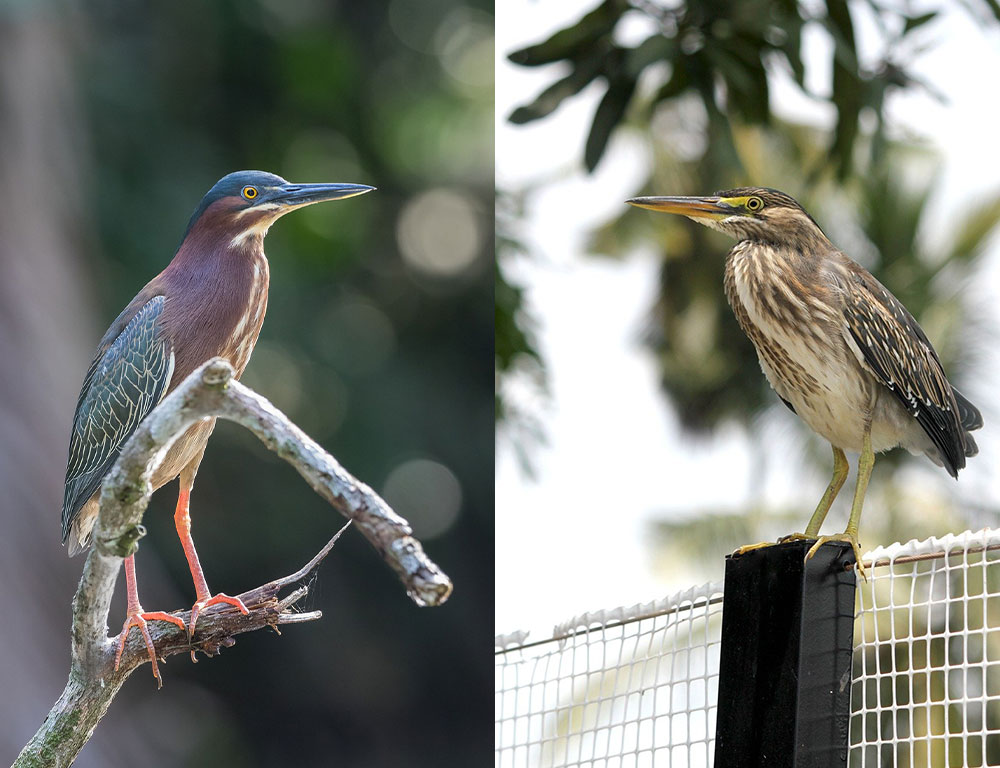
The Green Heron (Butorides virescens) and the Striated Heron (Butorides striata) are small wading birds from the same genus. Still, they have distinct differences in appearance, behavior, and habitat preferences.
Plumage Coloration
One of the primary differences between the two species is their plumage coloration. True to its name, the Green Heron exhibits a rich greenish-brown coloration on its upper parts.
At the same time, the Striated Heron has a predominantly gray-blue plumage with fine streaks or striations.
Size
Green Herons are slightly larger than Striated Herons, with adults typically measuring around 16-18 inches, whereas Striated Herons are smaller, averaging around 14-18 inches.
Neck Length
Green Herons have relatively shorter necks compared to Striated Herons. The latter species has a longer neck that can extend and retract while hunting or displaying.
Habitat Preference
While both species are commonly found in wetland habitats, they exhibit different habitat preferences.
Green Herons tend to inhabit freshwater habitats such as marshes, ponds, and streams, whereas Striated Herons are more commonly associated with coastal areas, mangroves, and estuaries.
Geographic Range
The Green Heron’s distribution is primarily in North and Central America, with some populations also found in parts of South America.
In contrast, the Striated Heron has a more extensive global distribution in Africa, Asia, Europe, and the Americas.
Breeding Behavior
Green Herons typically breed solitarily or in loose colonies, constructing nests from sticks and vegetation in trees or shrubs near water.
Striated Herons also breed solitarily but may form small colonies during the breeding season, often nesting in dense vegetation near water.
Vocalizations
While both species are known to vocalize, their calls differ. Green Herons produce a distinctive series of “kuk” or “skeow” calls, whereas Striated Herons have a variety of vocalizations including squawks, calls, and alarm signals.
While the Green Heron and Striated Heron share similarities in their ecology and behavior, their differences in plumage, size, habitat preference, geographic range, breeding behavior, and vocalizations distinguish them as separate species within the genus Butorides.
5 Interesting Facts About Striated Heron
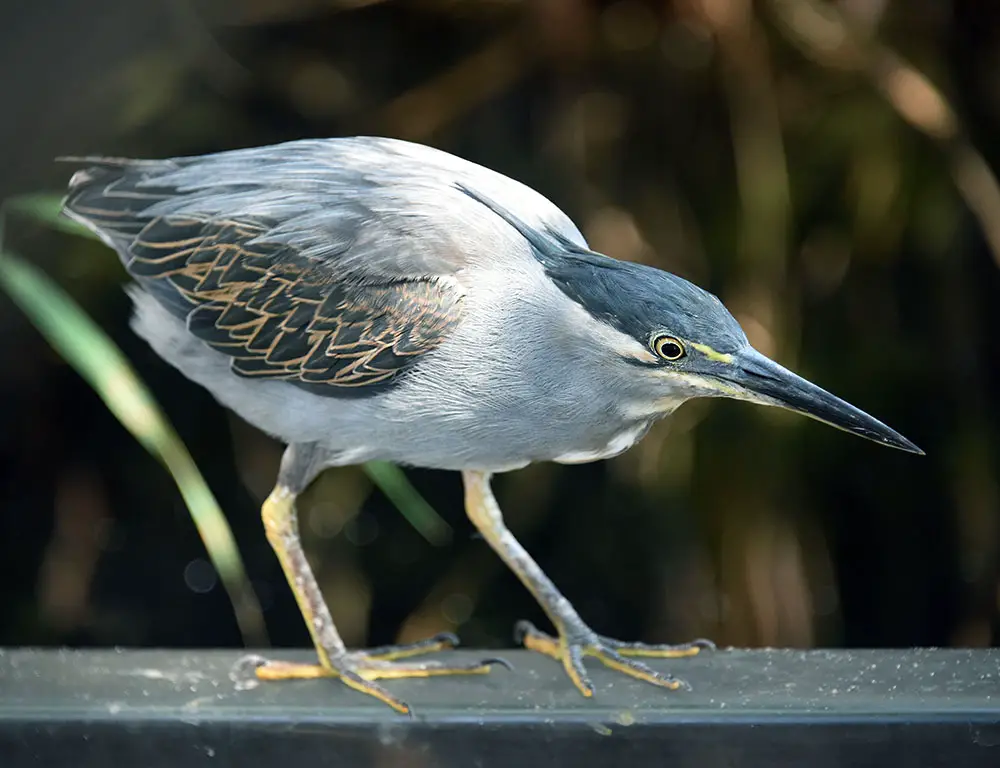
Here are five interesting facts about the Striated Heron (Butorides striata):
1. Master Of Stealth
The Striated Heron is renowned for its stealthy hunting technique. It remains motionless for long periods, patiently waiting for prey to come within striking distance, then swiftly strikes with its sharp bill to catch fish, amphibians, crustaceans, and insects.
2. Adaptable Habitat
Despite its small size, the Striated Heron is remarkably adaptable and can be found in many wetland habitats, including mangroves, marshes, rivers, lakes, ponds, and estuaries. Its versatility allows it to thrive in both freshwater and saltwater environments.
3. Nesting Adaptations
Striated Herons are skilled nest builders, constructing nests from sticks, twigs, and vegetation in trees, bushes, or reed beds near water. Their nests are often placed high above the ground to protect against flooding and predators, providing a haven for raising their chicks.
4. Feathered Camouflage
The plumage of the Striated Heron provides excellent camouflage against its surroundings, helping it blend seamlessly into its wetland habitat.
Its gray-blue coloration with fine streaks or striations helps conceal it from prey and predators, allowing it to remain undetected while hunting or roosting.
5. Global Distribution
The Striated Heron has a vast geographic range in various regions across Africa, Asia, Europe, and the Americas.
Its widespread distribution highlights its adaptability and ability to thrive in diverse ecosystems, making it a fascinating subject of study for ornithologists and bird enthusiasts worldwide.
Conclusion
The Striated Heron stands as a testament to the resilience and adaptability of avian species in the face of changing environmental conditions. Its ability to thrive in diverse wetland habitats worldwide highlights the importance of conserving these fragile ecosystems.
As we strive to protect and preserve the habitats of the Striated Heron, we also safeguard the rich biodiversity of wetlands and ensure the continued survival of this charismatic wading bird for generations to come.
Through continued research, education, and conservation efforts, we can work towards a future in which the Striated Heron and its wetland habitats remain thriving components of our natural world.